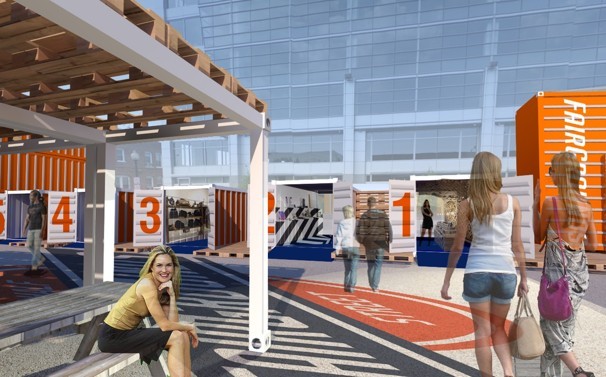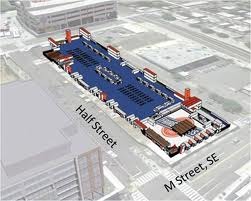HALF STREET FAIRGROUNDS
 Friday, May 25, 2012 at 3:38PM
Friday, May 25, 2012 at 3:38PM The Navy Yard is one of the areas of DC where you can see a very dramatic physical change over the past decade, with new office buildings and condos springing up on land where warehouses used to stand. Probably the most well known of these new developments is the Nationals Park. Opening in 2008, it was meant, in part, to help usher in more mixed-use development. Advertisements for planned residences pictured throngs of people enjoying shopping and entertainment. However, the opening of the baseball stadium coincided with the unfortunate economic downturn, and many of the new building proposals were postponed or cancelled, leaving vacant land in a few cases.
This national economic downturn helped give rise to a movement dubbed “Lighter, Quicker, Cheaper”. The Project for Public Spaces described this movement as an approach “based on taking incremental steps, using low-cost experiments, and tapping into local talents (e.g. citizens, entrepreneurs, developers, and city staff). These smaller-scale projects are being implemented in a variety of environments, including on streets, squares, waterfronts, and even parking lots.” A parallel development known as Pop-up retail also became more frequent during this downturn, and it emphasized the use of temporary space for interim stores, galleries, or social events.
Both trends came together recently in the Navy Yard neighborhood when the firm developing the site directly across from one of the Navy Yard Metro entrances (and a block away from the Ballpark) decided to create a space called Half Street Fairgrounds. The idea was to enclose the lot and have an area inside that offered food, drink, concerts, games, retail, and spaces to sit in the shade, stand and socialize, or hold public events until construction began on their mixed-use project.

How has this space worked out? After visiting the site last weekend, I was struck by the relatively small crowds inside. Maybe more people came after the Nationals game in progress was over, but it was not quite the hub I was expecting it to be. Having also visited the site while the food truck festival Truckeroo was in full force (before the current plans were completed), it was definitely a marked change from the crowds seen before.

From a design standpoint, the orange, blue, and white metal salvaged shipping containers that form the walls are striking and give a nod to the area's industrial history. The containers also have clear windows on one end, which are meant to engage the streetscape with retail functionality. Unfortunately, the funtion of the windows as designed did not last more than a week before the company that managed the retail portion pulled out of the project, citing poor sales. The executive director, Michael Berman, thought the vending and retail aspects could not work without a complete redesign, although he thought “the space is well designed to serve alcohol products and that the stage, sound, and food trucks compliment that use”. However, the Fairgrounds developer Bo Blair disagreed and thought that a different set of vendors would be successful.
I am not sure who ultimately will be correct about the viability of retail at the Fairgrounds, but they both are correct about the success of the entertainment portion since the site looks like one big beer garden, with a few platforms on the edges and bean toss games to one side. Given the relative sparseness of the crowd at the time I was there, this could turn out to be a problem, since the space was designed for large crowds and does not appear to be very interesting without them.
Definitely visit and make your own critique. The Fairgrounds are open daily from 11:30 a.m.
 Fairgrounds,
Fairgrounds,  LQC,
LQC,  Navy Yard,
Navy Yard,  Pop-up retail,
Pop-up retail,  Project for Public Spaces in
Project for Public Spaces in  Community
Community 